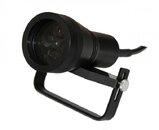I don't think any of the fragile HID bulbs are in use any more. Unless you buy a very old light, you're going to be getting the Brightstar bulb, which you can pound nails with. I am in no way careful with my HID lights, except for avoiding turning them on and off more than necessary. I seem to get four or five years off a bulb. Most of my problems with my lights have had to do with the wires and Anderson connectors, and the soldered connections into the LiIon control circuitry. And as I said, we have had few malfunctions.
Early on, I had a latch rust through (Salvo, LM's predecessor, got a batch of bad stainless latches). I called LM and told them I was leaving on a trip to Indonesia and wanted to take the light with me. They not only sent me a latch (and talked me very carefully through the installation procedure, which consists of screwing the latch on but NOT stripping the threads in the drilled channel in the Delrin, which they were worried I might do) but they FED EXED it at their own expense. On another occasion, I had a light fail a week before a cave diving trip. They came into the shop on Saturday, when they were closed, so that a friend of mine who was in Florida could pick the light up and bring it home to me in time.
I don't know Bobby, but he does seem to have a good reputation. I do know Light Monkey -- since before they were Light Monkey.
Early on, I had a latch rust through (Salvo, LM's predecessor, got a batch of bad stainless latches). I called LM and told them I was leaving on a trip to Indonesia and wanted to take the light with me. They not only sent me a latch (and talked me very carefully through the installation procedure, which consists of screwing the latch on but NOT stripping the threads in the drilled channel in the Delrin, which they were worried I might do) but they FED EXED it at their own expense. On another occasion, I had a light fail a week before a cave diving trip. They came into the shop on Saturday, when they were closed, so that a friend of mine who was in Florida could pick the light up and bring it home to me in time.
I don't know Bobby, but he does seem to have a good reputation. I do know Light Monkey -- since before they were Light Monkey.





